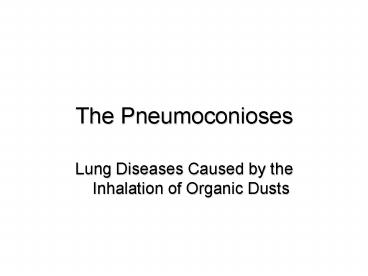The Pneumoconioses - PowerPoint PPT Presentation
1 / 15
Title:
The Pneumoconioses
Description:
You must know the following regarding any patient with a possible pneumoconiosis: ... Nodule and macule formation seen on radiograph as well as interstitial fibrosis ... – PowerPoint PPT presentation
Number of Views:676
Avg rating:3.0/5.0
Title: The Pneumoconioses
1
The Pneumoconioses
- Lung Diseases Caused by the Inhalation of Organic
Dusts
2
Patient History
- You must know the following regarding any patient
with a possible pneumoconiosis - Duration of exposure
- Intensity of exposure
- Where employed
- Other related pulmonary history
3
Coal Workers Pneumoconiosis
- Common name--Black Lung
- Cause--inhalation of coal(Carbon) dust
- Pathology--repeated inhalation causes mucociliary
escalator to fail--dust bypasses conduction
airways and enters gas exchange
airways--macrophages cannot digest coal dust,
hence, macrophages die---and chronic inflammatory
reaction of a-c membrane occurs
4
CWP--result of chronic inflammation of a-c
membrane
- Deposition of protein at site of reaction
- This causes what is known as interstitial
fibrosis - CWP is usually seen in apical portions of the
lung - Many of these patients also have TB
- This disease is NOT treatable...but is preventable
5
CWP
- Nodule and macule formation seen on radiograph as
well as interstitial fibrosis - Early, this lung disease appears as COPD
- Palliative treatment w/supplemental O2
- Bronchodilators and steroid therapy are often
used as well to promote reversal of airways
restriction and bronchial hygiene
6
CWP--who gets it
- Underground miners
- Families of miners when exposed to their
dust-filled clothing
7
Silicosis
- Inhalation of silicon dioxide or free silica
- Etiology is similar to CWP with interstitial
fibrosis formation - Usually affects apical lung zones
- After exposure, the reactive process in the lung
will continue for as long as six months after
stopping exposure
8
Silicosis
- Is not treatable
- BUT, IT IS PREVENTABLE
9
Silicosis--who gets it
- Sandblasters
- Coal miners
- Chippers and caulkers in shipyards
- Foundry workers using sand castings
10
Asbestosis
- Fibers are needle-like in their appearance
- Once inhaled, macrophages cannot digest
- Inflammatory reaction at a-c membrane
- Interstitial fibrosis develops
- Commonly seen in the basilar lung zones
- These particles can break through alveolar
membrane and be carried to all other organ
systems, including pleural space
11
Asbestosis--who gets it
- Combined w/smoking--pleural mesothelioma
- Brake shoe workers
- Auto mechanics
- Asbestos miners
- Asbestos workers
12
Byssinosis
- Etiology is the inhalation of cotton dust
- Common name-- Brown Lung
- Commonly affects upper and middle lung zones
- These patients have decreased FEV1s on Monday
mornings - Pathology similar to the other pneumoconioses
13
Typical Evaluative Studies of Pneumoconises
- Progressively decreasing PO2s and Sats
- PFTs demonstrate restrictive airways disease
- Decreases in RV, FRC and TLC
- Decreases in expiratory flow rates due to
decreased lung volumes and not necessarily
airways obstruction
14
Typical Evaluative Studies of Pneumoconises
- Many of these patients have COR PULMONALE (R
heart failure) secondary to increased pulmonary
vascular resistance
15
Other Pneumoconioses
- Bauxite workers disease (Aluminum ore)
- Talcosis
- Tungsten workers disease
- Carbide workers disease































